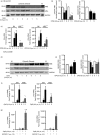CpG-ODN-mediated TLR9 innate immune signalling and calcium dyshomeostasis converge on the NFκB inhibitory protein IκBβ to drive IL1α and IL1β expression
- PMID: 32064589
- PMCID: PMC7160659
- DOI: 10.1111/imm.13182
CpG-ODN-mediated TLR9 innate immune signalling and calcium dyshomeostasis converge on the NFκB inhibitory protein IκBβ to drive IL1α and IL1β expression
Abstract
Sterile inflammation contributes to many pathological states associated with mitochondrial injury. Mitochondrial injury disrupts calcium homeostasis and results in the release of CpG-rich mitochondrial DNA. The role of CpG-stimulated TLR9 innate immune signalling and sterile inflammation is well studied; however, how calcium dyshomeostasis affects this signalling is unknown. Therefore, we interrogated the relationship beτween intracellular calcium and CpG-induced TLR9 signalling in murine macrophages. We found that CpG-ODN-induced NFκB-dependent IL1α and IL1β expression was significantly attenuated by both calcium chelation and calcineurin inhibition, a finding mediated by inhibition of degradation of the NFκB inhibitory protein IκBβ. In contrast, calcium ionophore exposure increased CpG-induced IκBβ degradation and IL1α and IL1β expression. These results demonstrate that through its effect on IκBβ degradation, increased intracellular Ca2+ drives a pro-inflammatory TLR9-mediated innate immune response. These results have implications for the study of innate immune signalling downstream of mitochondrial stress and injury.
Keywords: cytokines; inflammation; monocytes/macrophages; rodent; transcription factors; transgenic/knockout mice.
© 2020 John Wiley & Sons Ltd.
Conflict of interest statement
The authors declare no potential financial or ethical conflicts of interest.
Figures







Similar articles
-
CpG oligonucleotide activates Toll-like receptor 9 and causes lung inflammation in vivo.Respir Res. 2007 Oct 9;8(1):72. doi: 10.1186/1465-9921-8-72. Respir Res. 2007. PMID: 17925007 Free PMC article.
-
Inhibition of IκBβ/NFκB signaling prevents LPS-induced IL1β expression without increasing apoptosis in the developing mouse lung.Pediatr Res. 2017 Dec;82(6):1064-1072. doi: 10.1038/pr.2017.182. Epub 2017 Aug 23. Pediatr Res. 2017. PMID: 28753596 Free PMC article.
-
Bacterial DNA induces myocardial inflammation and reduces cardiomyocyte contractility: role of toll-like receptor 9.Cardiovasc Res. 2008 Apr 1;78(1):26-35. doi: 10.1093/cvr/cvn011. Epub 2008 Jan 14. Cardiovasc Res. 2008. PMID: 18194990
-
Single Stranded DNA Immune Modulators with Unmethylated CpG Motifs: Structure and Molecular Recognition by Toll-Like Receptor 9.Curr Protein Pept Sci. 2019;20(11):1060-1068. doi: 10.2174/1389203720666190830162149. Curr Protein Pept Sci. 2019. PMID: 31470785 Review.
-
DNA motifs suppressing TLR9 responses.Crit Rev Immunol. 2006;26(6):527-44. doi: 10.1615/critrevimmunol.v26.i6.50. Crit Rev Immunol. 2006. PMID: 17341193 Review.
Cited by
-
Calcium Ions Signaling: Targets for Attack and Utilization by Viruses.Front Microbiol. 2022 Jul 4;13:889374. doi: 10.3389/fmicb.2022.889374. eCollection 2022. Front Microbiol. 2022. PMID: 35859744 Free PMC article. Review.
-
Immunostimulatory Effects of Guanine-Quadruplex Topologies as Scaffolds for CpG Oligodeoxynucleotides.Biomolecules. 2025 Jan 10;15(1):95. doi: 10.3390/biom15010095. Biomolecules. 2025. PMID: 39858489 Free PMC article.
-
When Innate Immunity Meets Angiogenesis-The Role of Toll-Like Receptors in Endothelial Cells and Pulmonary Hypertension.Front Med (Lausanne). 2020 Jul 31;7:352. doi: 10.3389/fmed.2020.00352. eCollection 2020. Front Med (Lausanne). 2020. PMID: 32850883 Free PMC article. Review.
-
Hydroxyapatite nanoparticles drive the potency of Toll-like receptor 9 agonist for amplified innate and adaptive immune response.Nano Res. 2022;15(10):9286-9297. doi: 10.1007/s12274-022-4683-x. Epub 2022 Jul 23. Nano Res. 2022. PMID: 35911480 Free PMC article.
-
Loss of STIM1 and STIM2 in Salivary Glands Disrupts ANO1 Function but Does Not Induce Sjogren's Disease.Function (Oxf). 2025 Feb 12;6(1):zqae047. doi: 10.1093/function/zqae047. Function (Oxf). 2025. PMID: 39479800 Free PMC article.
References
Publication types
MeSH terms
Substances
Grants and funding
LinkOut - more resources
Full Text Sources
Molecular Biology Databases
Miscellaneous

